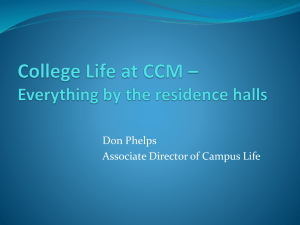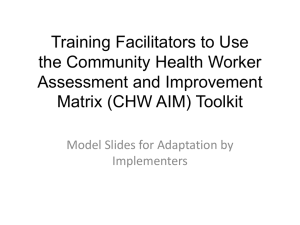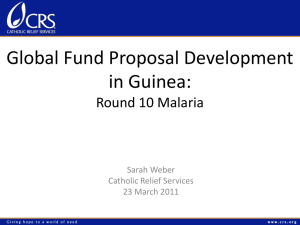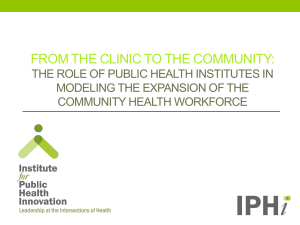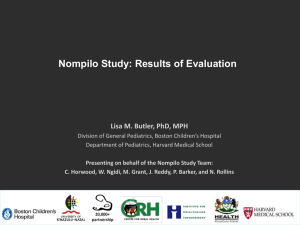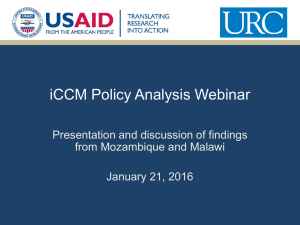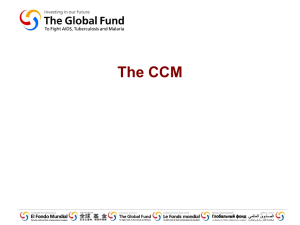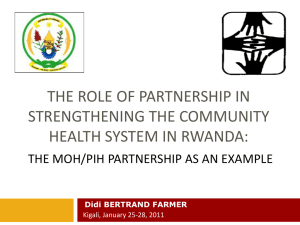Power Point Slide Presentation
advertisement
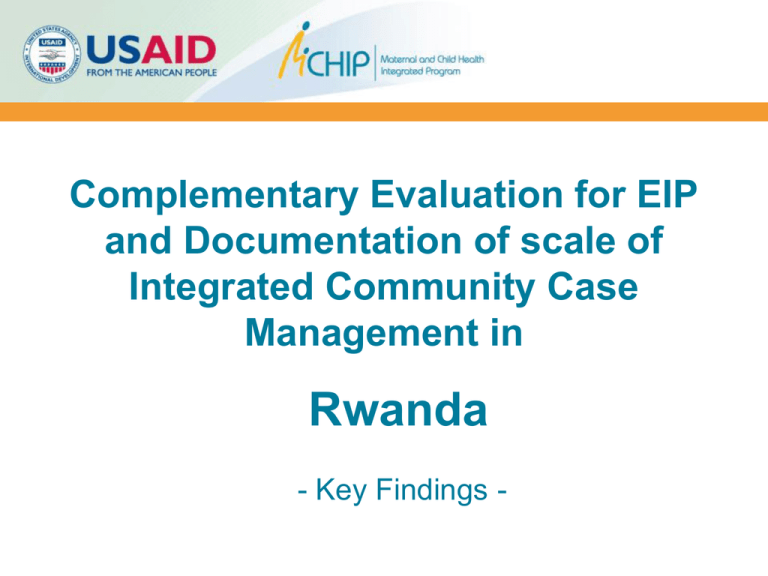
Complementary Evaluation for EIP and Documentation of scale of Integrated Community Case Management in Rwanda - Key Findings - Presentation Outline I. II. III. IV. V. VI. Background Objectives Methodology Results Lessons Learned Next Steps 2 Background EIP CSHGP Program: Contributions to Scale: Cross-District Comparisons: •Focused on iCCM, CHW training, supervision and supply chain •What was Rwanda’s planned versus actual pathway to scale for iCCM? •How does the Care Group model compare with the existing default model of C-IMCI in Rwanda? And what lessons can be learned from its experience? •Encouraging peer support through CHW Care Groups •How did EIP contribute to pathway? Menu of Key Strategic Tasks by Timeline Pre-introduction from unaware/ uninterested to building consensus convene interested partners begin change process characterize problem/consider possible solutions test/ refine approaches (pilot) cultivate champions Definitive decisions consensus building to motivating secure official policy endorsement/ approval Introduction motivating to implementing do detailed implementation planning develop an M&E secure financial plan commitments formalize permanent working group develop - MCHIP Early implementation implementing conduct orientations & training Mature implementation implementing to sustaining maintain oversight monitor fidelity ensure availability monitor and of drugs & supplies evaluate outcomes at point of service and impact training curricula monitor inputs, expand processes and & plans geographically quality procure institutionalize address barriers needed drugs, adapt as needed supplies address address capacity issues unintended consequences 4 Objectives of Complementary Study Scale Study: To test the following Hypotheses •NGO supported actions around HBM (2004) and iCCM (2007) were essential in leveraging MOH support for scale •Strong leadership and political will in Rwanda were key in moving CCM to scale Comparative Study: To assess Care Group attribution to CCM status 5 Methodology The Complementary Study comprised of 3 different tasks. Document Review (20012011) Qualitative elicitation of narratives by key informants (central level stakeholders) to “tell the story” of iCCM in Rwanda over time (2001-2011) Qualitative assessment of CCM status in one non-EIP district (Ruhango) 6 Focus Group Interviews Interviews and FGDs Conducted Target Done Central MOH & Central Partners (USAID, UNICEF, WHO, PNILP, NGOs) Technical persons 5 District Health Officer 1 Health professionals (Titulaire, CSC) CHWs 2 Mothers / Caretakers Cooperative Officials 1 MOH 11 NGO/Bilaterals FGDs FGDs FGDs RESULTS 1: CCM Timeline in Rwanda HBM Strategic Plan 2004 Expansion of HBM to 12 of 19 “endemic” Districts 2006 HBM Evaluations 2006 and 2007 using ACT Expansion of iCCM to 30 Districts 2009-2010 iCCM Tool Development and revision 2008-2010 2009-Introduction of RDT at community level iCCM Pilot in Kirehe 2007 Rwanda CCM Timeline POLICY PHC HBM TWG HBM Strategic Plan CHW CCM Cadre mooted IMCI TWG CH Policy + Community Health Desk C-PBF to incentivize CHWs MCH CH TWG takes over from IMCI TWG. Homebased fluid, ORS & Zinc in Kirehe DIARRHEA Pilot AQ at village level in 6 districts MALARIA Oct 07: Bukora HC 1st ACT Tx by CHW RDT Policy Change Feb 08: 1st Pneumonia case treated by a CHW in Kirehe PNEUMONIA HBM in 6 Districts EXPANSION 1990’s 2003 2004 HBM in all 19 endemic Districts 2005 2006 Expansion of iCCM to 16 Districts 2008 (Phase 1) 2007 2008 Expansion of iCCM to 30 Districts 2009-2010 2009 2010 Other Important Critical Events for CCM in Rwanda Vision 2020 Umurenge of 2000 and Decentralization Policy of 2001 Global Fund Round 3, 5, 8, RCC WHO TA for HBM 2004 Senegal Visit - 2006 BASICS TA for ICCM 2007 CHW Recognition by the Presidency - 2008 New Staff Cadre for CHW Supervision - 2010 HBM NGO pilot CORE/PMI support 2004 10 RESULTS 2: CHWs and Care Groups The EIP intervened at critical points in the pathway to iCCM scale. CHW Services are appreciated by both users and MOH. Care Groups at the CHW level provide a natural peer support group and help with Community mobilization and BCC. 12 Potential CCM Challenges that Care Groups could help alleviate Key CCM Factors EIP Districts Non-EIP Districts (with CHW Peer (without CHW Peer Support Groups) Support Groups) Improving Task Competency for CCM e.g. use of timer, MUAC, RDT (Supervision/QA) + - Minimizing stock-outs by sharing inventory (Motivation) + - Technical Supervision by Peers + - Pooling/ Sharing Cases among CHWs to maintain CCM proficiency + - 13 Lessons Learned: MCHIP’s Considerations MCHIP validated the hypotheses it was testing. Now to consider - co-opting peer support group formation and networking module in CHW training; - testing different CHW restocking models/ supervision models 14 Next Steps Compare DHS clusters from EIP and non-EIP areas from the recent DHS (2010) Convene a face to face meeting for mutual agreement of CCM events timeline 15 ANY QUESTIONS? Thank you! wwww.mchip.net Follow us on:
